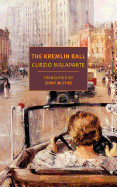
The Kremlin Ball is yet another underappreciated jewel of a novel unearthed by New York Review Books and translated into English for the first time by Jenny McPhee. Originally published after Curzio Malaparte's death in 1957, The Kremlin Ball draws heavily from real life in its depiction of Soviet "high society" in 1929. McPhee writes in her introduction: "In this novel... everything is true: the people, the events, the things, the places. The characters did not originate in the author's imagination, but were drawn from life." The characters include a host of famous historical figures, including Stalin, but even lesser-known figures are described in the footnotes.
Malaparte's talents as a writer include his acid wit and an eye for detail. In his hands, the higher levels of Soviet society prove just as ridiculous and corrupt as the aristocratic societies of Europe. The tennis matches, affairs, scandals and society gossip that define court life in Europe are conducted in Moscow, however, in a pervasive atmosphere of fear: "The chief characteristic of the communist nobility is not bad taste, vulgarity, or bad manners, nor is it complacency of wealth, luxury, and power: it is suspicion." Many in the Soviet leadership will have a bad end--Stalin's consolidation of power and the coming Great Purge loom large in the book. Malaparte's sense of humor is pitiless, memorably referring to Lenin's embalmed corpse as a "precious crustacean." Kremlin Ball is a terrifically funny and entertaining portrait of a seemingly powerful group of people dancing on the brink of destruction. --Hank Stephenson, bookseller, Flyleaf Books, Chapel Hill, N.C.

